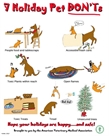

WALTZ ANIMAL CLINIC
1300 Osage Drive
Madison, IN 47250
(812) 273-6668
1300 Osage Drive
Madison, IN 47250
(812) 273-6668
"Our Best Care for Your Best Friend"
Visit Us On:
WALTZ ANIMAL CLINIC IS A FULL SERVICE ANIMAL HOSPITAL
FUN FACTS
Click on any link below to read the article.
To search simple press "Ctrl" plus the "F" Key simultaneously and a search block will open at the top of your screen. Then simply enter what you are searching for.
To search simple press "Ctrl" plus the "F" Key simultaneously and a search block will open at the top of your screen. Then simply enter what you are searching for.
Click the Picture for Tidbits of Trivia You Might Not Have Known
The holidays are certainly a festive time, but they can also be a risky time for your pets.
The AVMA has developed a fun graphic highlighting seven things to avoid this holiday season to help keep your pets happy and safe
The AVMA has developed a fun graphic highlighting seven things to avoid this holiday season to help keep your pets happy and safe
Butler will serve communities hit by severe weather for The Weather Channel and the American …After scouring shelters across the country, The Weather Channel and the American Humane Association have found the perfect weather therapy dog. Butler, a 1 ½-year-old Shepherd mix, was only at the Humane Society of Charlotte, N.C., for four days before he got the new gig.
The 35-pound pup quickly stole the hearts of Weather Channel producers and AHA representatives. "The perfect therapy dog, Butler is affectionate, loves to kiss and sit in the laps of others," the AHA said in a statement. "He is attentive, well-mannered and energetic, and will play a vital role in the health of communities in times of disaster."
When severe weather strikes a community, Butler and his AHA handler, Amy McCullough, will visit area schools, hospitals and shelters to offer comfort
The 35-pound pup quickly stole the hearts of Weather Channel producers and AHA representatives. "The perfect therapy dog, Butler is affectionate, loves to kiss and sit in the laps of others," the AHA said in a statement. "He is attentive, well-mannered and energetic, and will play a vital role in the health of communities in times of disaster."
When severe weather strikes a community, Butler and his AHA handler, Amy McCullough, will visit area schools, hospitals and shelters to offer comfort

Alexis Madrigal of The Atlantic Magazine explores the science of animals shaking themselves dry. See the fascinating slow motion video
Pets have steadily become cherished friends in American homes, with some on equal status as a family member. Therefore, it is with increasing frequency that dogs have been appearing in marriage ceremonies accompanying the couple as all three (sometimes, more) become one household.
A quick search on the internet of “dogs in weddings” returned 63 million results. 63 MILLION! (Not to be outdone, “cats in weddings” had 44 million results). It seems that the saying “Love me, love my dog”, is being taken quite seriously.
Dogs have been featured as ring bearers, walking the bride down the aisle and alongside the couple as vows are exchanged. But even the best plans can be undone when dealing with a dog that might be a tad uncomfortable with a large gathering and all eyes upon him or her.
The New York Times wrote of a man who brought his white German Shepherd as honorary bridesmaid to the wedding, when just prior to the start of the ceremony he spied her getting ready to relieve herself. He ran to her, scooped her up and took her outside until matters were settled to return to a round of applause from the waiting guests.
Other humorous stories documented included the dog that snatched the bride’s tossed bouquet and dogs dancing with guests at the reception. Another story involved a dog facing a “no dogs allowed” policy, so a friend of the bride and groom placed a jacket on the dog, slipped him into the church and sat quietly on the pew as he watched the nuptials.
So don’t be surprised to see a four-legged friend at the next wedding you attend. Or if you see a chicken. Yes, a chicken. But that’s a story for another issue.
Photo: dreamstime/Carisak
A quick search on the internet of “dogs in weddings” returned 63 million results. 63 MILLION! (Not to be outdone, “cats in weddings” had 44 million results). It seems that the saying “Love me, love my dog”, is being taken quite seriously.
Dogs have been featured as ring bearers, walking the bride down the aisle and alongside the couple as vows are exchanged. But even the best plans can be undone when dealing with a dog that might be a tad uncomfortable with a large gathering and all eyes upon him or her.
The New York Times wrote of a man who brought his white German Shepherd as honorary bridesmaid to the wedding, when just prior to the start of the ceremony he spied her getting ready to relieve herself. He ran to her, scooped her up and took her outside until matters were settled to return to a round of applause from the waiting guests.
Other humorous stories documented included the dog that snatched the bride’s tossed bouquet and dogs dancing with guests at the reception. Another story involved a dog facing a “no dogs allowed” policy, so a friend of the bride and groom placed a jacket on the dog, slipped him into the church and sat quietly on the pew as he watched the nuptials.
So don’t be surprised to see a four-legged friend at the next wedding you attend. Or if you see a chicken. Yes, a chicken. But that’s a story for another issue.
Photo: dreamstime/Carisak

Cat cafes first cropped up in Japan and have spread to Vienna, London and now Paris, where a planned cafe is welcomed by some and worrying others. While some wonder whether cats will thrive in such a setting, the owner said interactions between humans and cats will be strictly on feline terms, and she says she is working closely with a veterinarian. The idea behind the concept is to promote the human-animal bond in an urban setting where pet ownership may be difficult. Former AVMA President Dr. Gregory Hammer says the benefits of that connection are clear. "The human-animal bond has been well-documented, and I do believe the ability to pet and interact with purring cats is a stress reducer," Dr. Hammer said.
Have you ever wondered why you have to bring your pet's poop with you when you see your veterinarian? In AVMA's latest Kid Vid, Jonathan asks Dr. Tracy, "Why do I need to bring a stool sample to the vet?"
Politics apparently spills into pet preferences, with Republican-leaning states favoring dogs and many Democratic-leaning states being more feline-inclined. The AVMA's recently released U.S. Pet Ownership & Demographics Sourcebook ranks dog, cat and overall pet ownership by state, and nine of the top 10 dog-owning states went for Mitt Romney in the 2012 presidential election, while nine of the 10 states with the fewest dogs opted for President Barack Obama and four of the top five states for cat ownership also voted blue. Business Insider
Several dog breeds including poodles, soft-coated wheaten terriers and Portuguese water dogs have become known for their supposed lack of allergens, but a new study found that homes with breeds thought of as hypoallergenic had the same amount of dog allergens as other dog-owning households. "Allergists, based on their experience, really think that it's just individual dogs who have some variations based on genetics or behavior, who produce more allergens than others," said lead author Christine Cole Johnson.
Teens who were exposed to cats before age 1 were almost 48% less likely to develop allergic reactions to the pet, according to a study in the journal Clinical & Experimental Allergy. Researchers also found a 67% lower risk of dog allergy in both male and female teens born via cesarean section who were exposed to dogs before age 1.
The American Kennel Club introduced Wednesday three new breeds of dogs to be included in the organization's registry. The American English Coonhound, Finnish Lapphund and Cesky Terrier each received the AKC paw-print and are to be included in shows and events held by the organization.
Where does your kitty go when you let her out? What do stray cats do all day? Do alley cats hang out with each other?
These are just some of the questions answered by a newly completed research project in which 42 free-roaming cats — some with no owner, some outdoor pets — were radio-collared and tracked for two years by researchers at the University of Illinois.
Together, the cats roamed 6,286 acres in and around the cities of Urbana and Champaign. The strays turned out to have surprisingly huge territories. One feral cat, a mixed breed male, had a home range of 1,351 acres, covering both urban and rural, residential and agricultural, forest and prairie areas.
That particular male cat was not getting food from humans, to my knowledge, but somehow it survived out there amidst coyotes and foxes," Jeff Horn, a former graduate student in the Department of Natural Resources and Environmental Sciences who led the study, said in a press release. "It crossed every street in the area where it was trapped. (It navigated) stoplights, parking lots. We found it denning under a softball field during a game."
Even though the free-roaming pet cats tended to stay within the two acres surrounding their homes, "some of the cat owners were very surprised to learn that their cats were going that far," Horn said. "That's a lot of backyards."
Another difference was that the pets engaged in vigorous activity, such as running or stalking, only 3 percent of the time, while the strays were active 14 percent of the time — they had to work harder to stalk and kill their own food.
Most of the cats tended to stay within 300 meters (984 feet) of human structures, said co-author Nohra Mateus-Pinilla, a wildlife veterinary epidemiologist at the Illinois Natural History Survey at Illinois. "Even feral cats were always within range of a building," she said. "That shows that even though they're feral, they still have a level of dependency on us."
As for whether alley cats hang out together: nope. The researchers observed one feral cat chasing another out of a dairy barn. Another stray waited for a pet cat to emerge each morning and tried to chase it out of its own backyard. In an earlier study, co-author Richard Warner, an emeritus professor of natural resources and environmental sciences, followed about two dozen free-roaming cats over several years, and found that the two leading causes of cat deaths were other cats and disease.
The study was published in the Journal of Wildlife Management. This article was provided by Life's Little Mysteries, a sister site to LiveScience.
These are just some of the questions answered by a newly completed research project in which 42 free-roaming cats — some with no owner, some outdoor pets — were radio-collared and tracked for two years by researchers at the University of Illinois.
Together, the cats roamed 6,286 acres in and around the cities of Urbana and Champaign. The strays turned out to have surprisingly huge territories. One feral cat, a mixed breed male, had a home range of 1,351 acres, covering both urban and rural, residential and agricultural, forest and prairie areas.
That particular male cat was not getting food from humans, to my knowledge, but somehow it survived out there amidst coyotes and foxes," Jeff Horn, a former graduate student in the Department of Natural Resources and Environmental Sciences who led the study, said in a press release. "It crossed every street in the area where it was trapped. (It navigated) stoplights, parking lots. We found it denning under a softball field during a game."
Even though the free-roaming pet cats tended to stay within the two acres surrounding their homes, "some of the cat owners were very surprised to learn that their cats were going that far," Horn said. "That's a lot of backyards."
Another difference was that the pets engaged in vigorous activity, such as running or stalking, only 3 percent of the time, while the strays were active 14 percent of the time — they had to work harder to stalk and kill their own food.
Most of the cats tended to stay within 300 meters (984 feet) of human structures, said co-author Nohra Mateus-Pinilla, a wildlife veterinary epidemiologist at the Illinois Natural History Survey at Illinois. "Even feral cats were always within range of a building," she said. "That shows that even though they're feral, they still have a level of dependency on us."
As for whether alley cats hang out together: nope. The researchers observed one feral cat chasing another out of a dairy barn. Another stray waited for a pet cat to emerge each morning and tried to chase it out of its own backyard. In an earlier study, co-author Richard Warner, an emeritus professor of natural resources and environmental sciences, followed about two dozen free-roaming cats over several years, and found that the two leading causes of cat deaths were other cats and disease.
The study was published in the Journal of Wildlife Management. This article was provided by Life's Little Mysteries, a sister site to LiveScience.









